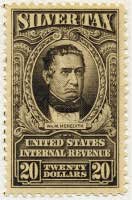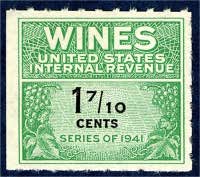
 |
The National Postal Museum Is About To Make A Taxing Mistake
By Ronald E. Lesher
 The National Postal Museum plans to sell or destroy millions of revenue stamps — stamps that show that a tax has been paid, whether it's for spirits, playing cards, newspapers or something else. The debate is stirring strong emotions among specialists in revenue stamps. Among them is Ron Lesher, a past president of the American Revenue Association and a Director-at-Large of the American Philatelic Society, whose board earlier this year rejected Lesher's motion to advise the NPM not to sell selected revenue stamps.
The National Postal Museum plans to sell or destroy millions of revenue stamps — stamps that show that a tax has been paid, whether it's for spirits, playing cards, newspapers or something else. The debate is stirring strong emotions among specialists in revenue stamps. Among them is Ron Lesher, a past president of the American Revenue Association and a Director-at-Large of the American Philatelic Society, whose board earlier this year rejected Lesher's motion to advise the NPM not to sell selected revenue stamps.
The impending actions of the National Postal Museum in deaccessioning [selling some of its collection] rarely-seen or -sold revenue stamps raise some serious issues in the philatelic community. There is no doubt in my mind that this event will provide a marvelous case study for future museums studies curricula. Will it be a positive example to be emulated or a list of things to be avoided by other museums? I hope for the former, but it may be the latter. Read on.
 1. Collecting Impact
1. Collecting Impact
May I suggest that the current discussions going on about the NPM deaccessions have some interesting parallels with the US Post Office sale of obsolete Newspaper and Periodical stamps about a hundred years ago. When I originally acquired my set of the final Newspaper and Periodical stamps many years ago, the prices were still a fraction of catalog value. The blot on those stamps from that sale continued at least into the 1970's, two generations removed from the event. For a hobby that is so closely allied with history, most of us are very poor students of the history of our own hobby. In contrast to Eric Jackson's view that the deaccessioning of all the stamps will stimulate the collecting of wine stamps, the best historical parallel suggests just the opposite. The two, and perhaps three, most advanced current collections of wine stamps will never have any of the deaccessioned wine stamps added to them! That is the depth of feeling among several serious collectors.
2. Exhibiting Impact
Think remaindered stamps, not archival material when considering the proposed deaccessioning of the wine stamps. One can just imagine the overheard discussions among the APS accredited judges when confronted by a wine stamp exhibit some time in the future:
"Oh, yes, these are from the NPM deaccessioning."3. NPM Image"They need to be here in the exhibit, but does anyone really care about these dumped stamps (snicker, snicker)."
"Were these stamps ever used?"
If the NPM proceeds on its current course of action of major disruptions to the rare revenue stamp market, it is not at all clear what changes in its public image will be occurring. Public perception is key to future fund raising efforts and should logically be a part of their analysis of maximizing revenue. There is a callous disregard for public image in the NPM press releases. Paraphrased they say, we need money, the stamps were permitted to be used to help bolster our collection, we will get the money we want by selling the remainders.
4. Maximizing Revenue The MBA Way
Ignoring the effect on public image, one logically could ask then if they are proceeding on a sound business model. Did the NPM do a study of marginal revenue under several scenarios of deaccessioning (an MBA approach to their project)? I touch on such studies in my high school calculus classes, although neither my students nor I are probably sophisticated enough to do the study that would stand up to academic rigor. It would appear that the NPM has not seriously examined how to maximize revenue! If they have, nothing about such an approach is suggested in any of the news releases. All of us might be surprised by the results (as I often am when I find the results of the problems in the textbook from which I teach).
5. Final Thoughts
One is reminded of the discussions during the Cold War. Herman Kahn and the Rand Corporation suggested that in the event of a nuclear exchange, all Americans could not be saved. So how many people should be saved? Once that question was answered, a plan could be developed and we could decide if the expenditures would be acceptable. The ethics of saving human lives were set aside.
In a similar fashion, the NPM has decided that the hoard of revenue stamps is a cash cow. They need money, so they can both save storage costs and raise needed revenue by deaccessioning the stamps. Given that assumption, the NPM has chosen to ignore business ethics regarding manipulations of the stamp market. The end justifies the means.
 Although I will not be impacted financially because as luck would have it I disposed of my wine stamp rarities at the top of the market before the deaccessioning plan was announced, I am wounded by the NPM's proposed deaccession. I have spent 30 years seriously collecting and exhibiting the wine stamps. In 1972 my exhibit garnered a silver bronze and I was ecstatic. Last year I was in the C of C's at Columbus. I had made it to the top! Perhaps I was even more ecstatic than when I got the silver bronze in 1972, but not a lot more. Now it was time to let others enjoy the stamps that enabled my triumph.
Although I will not be impacted financially because as luck would have it I disposed of my wine stamp rarities at the top of the market before the deaccessioning plan was announced, I am wounded by the NPM's proposed deaccession. I have spent 30 years seriously collecting and exhibiting the wine stamps. In 1972 my exhibit garnered a silver bronze and I was ecstatic. Last year I was in the C of C's at Columbus. I had made it to the top! Perhaps I was even more ecstatic than when I got the silver bronze in 1972, but not a lot more. Now it was time to let others enjoy the stamps that enabled my triumph.
My primary collecting interests have moved on, but I cannot turn my back on all the hurt that will be inflicted on those individuals who assisted me in my study and the exhibiting of the wine stamps. That is why I am so impassioned.
Would this discussion be any different if the NPM serendipitously discovered tomorrow that in 1918 the U.S. Post Office had transferred to them 500 sheets of the Inverted Jenny? May I remind you that the 1-7/10¢ wine is in some ways the icon to wine stamps as the inverted Jenny is to U.S. airmails.